Table of contents
The fresh, cress-like and sharp taste of watercress ( Nasturtium officinale ) is created by the mustard oil glycoside gluconasturtiin. Raw watercress can sometimes be found in stores as an organic product.
Use in the kitchen
Watercress ( Nasturtium officinale ), also called watercress, is an aquatic plant that is eaten as a culinary herb or vegetable. It has a fresh, spicy-tart, peppery, slightly hot taste that is somewhat reminiscent of radish, mustard and garden cress .
Can you eat watercress raw? You can eat watercress raw. Can you eat the flowers of watercress? In addition to the stems and leaves, the roots, seeds and flowers are edible raw.
How can you eat watercress? Watercress is a flavorful ingredient for all kinds of vegan or vegetarian recipes. Leaves, shoots, budding flowers and watercress sprouts are a healthy addition to salads and raw food dishes. As a wild salad, raw watercress can be mixed with young leaves of dandelion, nettle, birch, St. John's wort or yarrow . The herb is suitable raw for pestos, green smoothies, herb sauces, spreads or vegan herb butter. It harmonizes with fruits such as apples or oranges and refines marinades, potato recipes and steamed vegetables. Popular dishes with watercress are spinach and potato soups. Like spinach, watercress collapses when cooked. Cress is mostly added to soups towards the end of the preparation time so that the aroma, spiciness and ingredients are retained.
The decorative, edible watercress flowers are white and taste spicy. The small watercress seeds can be eaten raw, added to bread dough, used as a pepper substitute or ground into mustard. The alternative name water mustard comes from the latter use. The spicy roots can be used fresh and finely chopped as a spice.
Vegan recipe for raw vegetable salad with watercress
Ingredients (for 4 people): 100 g watercress (raw, organic or freshly picked), 1 orange (filleted), 1 raw fennel bulb (cut into thin slices), seeds from 1 pomegranate, 1 carrot (grated), 6 walnuts, 1 tbsp seed mixture (e.g.pumpkin seeds, linseed, sesame ), 1 tsp rapeseed oil, 1 tsp balsamic vinegar, 1 tsp apple syrup, a little salt and pepper.
Preparation: Mix raw watercress, orange fillets, fennel slices, pomegranate seeds and grated carrot with walnuts and seeds. Divide the raw vegetable mixture between 4 plates. For the dressing, mix the oil, vinegar, apple syrup, salt and pepper and drizzle over the vegan salad.
Tea preparation
Pour boiling water over 2 g (1 tsp = approx. 1.7 g) of dried watercress herb and strain the infusion through a tea strainer after 10 minutes. 1
Vegan recipes with watercress (raw) can be found under the note: " Recipes that have the most of this ingredient ".
| Not only vegans or vegetarians should read this: Vegans often eat unhealthily. Avoidable nutritional errors . |
Purchasing - Storage
Where can you buy watercress? In comparison to the widely used garden cress ( Lepidium sativum ), fresh watercress is rarely found in stores. Supermarkets such as Coop, Migros, Denner, Volg, Spar, Aldi, Lidl, Rewe, Edeka, Hofer or Billa as well as the organic supermarkets Denn's Biomarkt and Alnatura may sporadically stock the aquatic plant. Watercress in conventional or organic quality is occasionally available at weekly markets, in green boxes (seasonal boxes, subscription boxes), in organic shops or health food stores, and online. You can also buy it as germinated seeds or in pots. You can read more about growing your own in the "Growing your own" chapter.
Thanks to the fact that watercress is grown in Switzerland, which is unique in Europe, there are good opportunities to buy the fresh greens. Local weekly markets, organic, farm and health food stores occasionally offer watercress as a raw food. Organic watercress can be purchased online directly from the producer or via sales websites.
The availability of watercress varies depending on the size of the store, catchment area, etc. Our recorded food prices for the DA-CH countries can be found above under the ingredient image - and by clicking you can see their development at various suppliers.
Found in the wild - Season
The common watercress ( Nasturtium officinale ) is found worldwide in areas with a temperate climate. 3,10 In Switzerland it can be found in ditches and streams at collin-montane altitudes. 3
Where does watercress grow? As a wild plant, it grows on the shallow banks of slow-flowing watercourses, clear springs, streams, rivers, ditches, ponds and in stream reed beds (plant communities). These typical locations have given the aquatic plant alternative names such as brook cress, ground cress or ditch cress. It prefers clean, evenly tempered, slightly alkaline and nutrient-rich water in a sunny or partially shaded location. 1,4,5,7,8,9
What does watercress look like? True watercress is evergreen, hardy and grows on or in water. Its carpet-like spread over the water surface is considered a typical appearance. The fleshy, feathery leaves grow on 30-90 cm long, prostrate shoots that are hollow and grooved. The leaves are usually slightly notched and consist of 1-4 pairs of leaflets and a larger terminal leaflet. The white flowers, up to 0.5 cm in size, have 4 petals and yellow anthers. The fruit is a short, clearly stalked pod, with the seeds arranged in two rows inside. Roots sit loosely in the bottom of the water 3,4,5,10 and reach to a depth of one meter. 6
The herb is in season in spring and tastes best before flowering (from March to June ). Seeds are ready for harvest from September. To preserve the stock, the roots should be protected. 4, 5,10
Collection points must be carefully considered, as water bodies can be contaminated with pollutants and pathogenic organisms. 9 The collected cress is transported in a bag or bucket with water to preserve the aroma.
Leaves must be cleaned thoroughly before use, as they may contain insect larvae or liver fluke cysts, which can trigger the disease fascioliasis. 18 Read more about this in the chapter "Danger - Intolerances - Side Effects".
Storage tips
Fresh watercress has a short shelf life at room temperature (approx. 1 day). For longer storage, the aquatic plant can be wrapped in foil and kept in the refrigerator at 3-5 °C for a week.
The plant is less suitable for drying, as it loses some of its sharp, bitter properties. 8 Freezing results in a bland taste and a shrunken consistency of the leaves.
Ingredients - Nutritional values - Calories
What is the nutritional value of watercress? The watercress nutrients consist of 0.1 g fat, 1.3 g carbohydrates and 2.3 g protein per 100 g, which corresponds to a calorie content of 11 kcal/100g. 11
The content of 250 µg of vitamin K per 100 g is remarkable - around 30 g of the fresh greens can cover the daily requirement of an adult. Endive (231 µg/100g) and radicchio (255 µg/100g) have similar amounts of the vitamin. Nasturtium contains around half the amount at 125 µg/100g. Even more vitamin K can be found in raw garden cress (542 µg/100g), dandelion (778 µg/100g), kale (705 µg/100g) and chard (830 µg/100g). 11
The occurrence of 43 mg of vitamin C per 100 g is average - similar to that of lemon balm (45 mg/100 g) and lovage (45 mg/100 g). More vitamin C per 100 g can be found in raw garlic mustard (261 mg), raw wild garlic (150 mg), ground elder (140 mg), small sorrel (117 mg) or narrow-leaved willowherb (99 mg). 11 There are other sources that assume a higher vitamin C content. In the scientific literature, for example, one can find figures of 80 mg of ascorbic acid per 100 g or approx. 0.1% (= 100 mg). 2,5 A publication from 2008 also lists a value of 104 mg of vitamin C per 100 g. 22 According to this value, watercress is one of the foods richer in vitamin C. 2
100 g of watercress contains 160 µg of vitamin A (20% of the daily requirement).Butterhead lettuce (166 µg/100g) and willowherb (180 µg/100g) contain comparable amounts. With 1250 µg/100g, small sorrel is particularly rich in vitamin A. 11
The complete ingredients of watercress (raw), the coverage of the daily requirement and comparison values with other ingredients can be found in our nutrient tables. In the article Nutrients explained you will get a detailed insight into the topic.
Health effects
Is watercress healthy? True watercress ( Nasturtium officinale ) has a variety of health-promoting properties. Not only the secondary plant substances it contains (see next chapter), but also the nutrient content (minerals, vitamins) makes watercress an effective food in reducing chronic diseases and in convalescence. 10,19
Nasturtium officinale has also been clinically proven to be effective in treating sinusitis, acute bronchitis and urinary tract infections. 1
A randomized study of volunteers showed significant antioxidant effects (in relation to DNA damage and endogenous lipid peroxidation) after several days of ingestion of raw 27 watercress. 1,27 An in vitro model study with human cells confirmed that Nasturtium officinale juice can provide a high level of protection against benzo(a)pyrene-induced DNA damage (eg, from cigarette smoke) in human cells. 12
In animal experiments, the 15-day administration of watercress juice was found to provide significant protection against induced genotoxicity (genetic damage). Positive effects on the blood lipid spectrum after administration of watercress extract have also been described in animal models. 1
Secondary plant substances
Many of the health effects of watercress can be attributed to the secondary plant substances it contains. Our article on secondary plant substances provides an overview of the classification of substance groups, their occurrence in foods and possible effects on humans. True watercress contains the following secondary plant substances, among others: 1, 10,23,25,28
Isoprenoids: terpenes/terpene poids: monoterpenes (limonene, alpha-terpineol, pulegone), Monoterpenoid (eucalyptol=1,8-cineole), carotenoids : carotenes (beta-carotene), xanthophylls (lutein, zeaxanthin)
Alkaloids: Indole alkaloid (hirsutin)
Polyphenols: Phenolic acids: hydroxybenzoic acids (vanillic acid), hydroxycinnamic acids (caffeic acid, chlorogenic acid, ferulic acid derivatives, caffeoylmaleic acid); flavonoids: flavonols (quercetin, kaempferol, isorhamnetin, rutin), flavones (apigenin); tannins (proanthocyanidins); phenylpropanoids (myristicin)
Organic sulphur-containing compounds: Glucosinolates (gluconasturtiin, glucobrassicin, glucohirsutin, glucoiberin, glucosiberin, glucotropaeolin, 4-hydroxy-glucobrassicin, 4-methoxy-glucobrassicin); isothiocyanates (2-phenylethyl isothiocyanate)
However, it should be noted that the composition of secondary plant substances in watercress can vary depending on the variety, time of harvest and growing conditions. Therefore, quantities are only of limited use and should only be understood roughly.
Watercress has been the subject of numerous pharmacological studies that have demonstrated its antioxidant, anti-cancer, antibacterial, anti-inflammatory, chemopreventive and cardioprotective properties. Studies show that watercress extracts can combat the growth and metastasis of cancer cells in vitro . The therapeutic effects mentioned are due in particular to the secondary plant substances contained in the plant, such as glucosinolates, polyphenols (flavonoids, phenolic acids, proanthocyanidins), terpenes and carotenoids. 19, 23 A 2013 study attributes the antioxidant activity of watercress to the presence of flavonoids and glucosinolates. 28
The different organs of watercress show qualitative as well as quantitative differences in chemical composition. Aerial parts of the plant contain the greatest variety of compounds. For example, the highest content of glucosinolates was found in the flowers. The main component of the essential oil from flowers is limonene, while that of the essential oil from leaves is myristicin. However, the dominant compound in all parts of the plant is gluconasturtiin and the product of its hydrolysis, namely 2-phenylethylisothiocyanate (nasturtiin). 23
In a 2022 study, phenolic compounds from an extract of Nasturtium officinale showed significant antibacterial activity against common oral pathogens such as Streptococcus mutans, Staphylococcus aureus and Enterococcus faecalis . The researchers conclude that watercress extracts could therefore be effective in treating some microbial infections in the mouth. 29 Watercress is also effective against gram-positive and gram-negative pathogens. 2 The plant's own ingredient hirsutin was shown to have strong antibacterial activity against Helicobacter pylori in the laboratory using an agar plate dilution test. 1
The glucosinolates, also known as mustard oil glycosides, primarily gluconasturtiin, are responsible for the characteristically sharp taste of watercress. 1,23
Dangers - Intolerances - Side effects
Watercress and especially products made from it should not be consumed or taken in large quantities or regularly over a longer period of time (more than 6 weeks). Maximum quantities indicated on packaging must be observed. Children under 4 years of age and people with gastrointestinal ulcers or inflammatory diseases of the urinary tract or kidneys should avoid the leafy vegetable. 1,2,8 Recommended daily consumption amounts are around 20-30 g of fresh or 6 g of dried herb. 2,8
The reason for this is the mustard oil glycosides it contains, which metabolize in the body into free mustard oil, which irritates the mucous membranes. In rare cases, healthy people may experience gastrointestinal complaints. No interactions are known. 1,2
Liver fluke cysts can adhere to watercress. These are the developmental stages (primarily the infectious metacercariae) of the large liver fluke ( Fasciola hepatica ), which is widespread worldwide and is found primarily in temperate climate regions (e.g. France, Spain, Portugal, Latin America, East Asia). 24 In contrast to the small liver fluke ( Dicrocoelium dendriticum ), it can lead to the clinical picture of fasciolosis if ingested, which is reflected in symptoms such as upper abdominal pain and fever, and rarely jaundice. 18, 24 These symptoms appear 2 to 12 weeks after consuming contaminated plant components. They manifest themselves as an attack on the liver (rarely other organs) and can be easily treated with medication. 26
Use as a recognized medicinal plant
Neither HMPC ( Committee on Herbal Medicinal Products ) nor ESCOP ( Association of National European Societies for Phytotherapy ) have yet investigated watercress. According to Commission E ( Expert Committee on Herbal Medicinal Products ), the use of watercress for catarrh of the respiratory tract and for colds is recognized. 1,23
Folk medicine - natural medicine
Watercress has been used as a medicinal and nutritional plant for over 2000 years. 19 In ancient Greece, the historian Xenophon (5th century BC) recommended that the Persians give watercress to their children. This was supposed to make the children strong. Watercress was also considered a blood purifier in European folk medicine. 10
In traditional medicine, watercress is used today for coughs, and rarely for gingivitis (inflammation of the gums) and periodontitis. 1 Other traditional and folk medicine uses include hyperglycemia, high blood pressure, asthma, skin diseases, inflammatory processes in the mouth and throat, catarrh and the promotion of bile secretion. 5,23
Nasturtium officinale is also used for inflammatory diseases of the urinary tract. Due to the mustard oil glycosides it contains, an effect is plausible and known from empirical medicine. A free formulation with other herbal urological remedies such as birch leaves, goldenrod or hayhuckel root is useful. Note that the effectiveness is not comparable to chemical-synthetic urinary tract disinfectants or antibiotics. As a phytopharmaceutical , Nasturtium officinale cannot and should not replace short-term therapy with corresponding medications. 2
Adults drink 1 tablespoon of the freshly pressed juice 3-4 times a day and children over 4 years old drink 1 teaspoon 2-3 times a day after meals. To make tea, drink a cup 2-3 times a day. Ready-made medicines are used according to the package insert. Free, individual recipes have not been tested. According to empirical medicine, 15-20 g of freshly pressed plant juice is sufficient. 2
Ecological footprint - animal welfare
The CO 2 footprint is primarily used to assess the climate friendliness of a food. This depends on various aspects, such as cultivation method (conventional/organic), seasonality, country of origin, processing, transport and, if applicable, packaging. We have not found any values for the CO 2 footprint of watercress. But garden cress has a very small footprint of 0.4 kg CO 2 eq/kg, similar to other herbs ( parsley or dill ). 33
Controlled growing conditions and the general resistance of watercress to disease and infestation make it a popular crop for organic farming. 30 In conventional farming, phosphate-containing fertilizers are often used to promote plant growth. However, these contribute to the eutrophication of aquatic habitats and have a negative impact on the environment. 31 In organic farming, the use of such fertilizers and synthetic pesticides is prohibited, which is why you should prefer organic products.
For detailed explanations of various sustainability indicators (such as ecological footprint, CO2 footprint, water footprint), see our article: What does the ecological footprint mean?
Animal protection - species protection
The nectar of the watercress flower is only accessible to butterflies and bees, as it is located at the base of the sagging sepals. If the weather conditions are not optimal, spontaneous self-pollination takes place in the closed flowers. 14
Worldwide occurrence - cultivation
The original distribution area of Nasturtium officinale extends from Europe to Central Asia and the Arabian Peninsula, Macaronesia and North and Northeast Africa. As a neophyte (introduced species), the plant can now be found almost everywhere in the world (e.g. in North America, South America and Australia). 13,23,32
The helophyte (marsh plant) is adapted to growth in an aquatic environment and grows wild in gently flowing streams, ditches, on the edges of ponds, on swampy or marshy ground - mainly in temperate latitudes. 23,31,32
The first commercial cultivation of Nasturtium officinale was recorded in southern England in 1808. Today, watercress is grown as an herb throughout the world, including in the UK, USA, Spain, Portugal, New Zealand and China. The crop is grown artificially in lakes, ponds and slow-moving waters of rivers, canals and streams, or in hydroponic systems, including hydroponic greenhouses and vertical farms. 10,23,31
The cultivation of watercress has declined sharply. Isolated, small-scale cultivation areas can be found in karst regions with many springs. 16,17 Medicinal plant imports come from Eastern and Southeastern European countries 1 from controlled wild collection.
Growing your own
How can you grow watercress? As a potted plant, the marsh and aquatic plant needs a nutrient-rich mix of sand, garden soil and compost. The container is placed in a bowl of fresh water, which is changed every 2 days. For a 15-20 cm pot, use 3-4 cuttings. Shoots can be pinched off to encourage bushy growth. Root cuttings can be propagated directly in water. 9,15 You can grow watercress yourself without soil in a germination device on the windowsill (you can find details on germination in the article Phytic acid or phytate and soaking or germination ).
If you want to grow watercress in the garden, a loamy soil is suitable as it retains moisture well. As a light-germinating plant, the seeds are pressed lightly into the soil without covering them. The plant thrives in a partially shaded location. When can you harvest watercress? You can start harvesting when the plant is 10 cm tall by cutting off the leaves as needed. 15
Further information
Watercress ( Nasturtium officinale ) belongs to the family Brassicaceae or Cruciferae. As a member of the Brassicaceae, it is related to several popular food and spice plants such as broccoli, white cabbage, kale, radish and mustard, as well as to the model plant Arabidopsis thaliana . 19
The genus name Nasturtium is said to be derived from the Latin 'nasus tortus', meaning 'twisted nose', referring to the nose-wrinkling caused by the sharp, peppery smell of the seeds of Nasturtium officinale . 23 Its German name 'Brunnenkresse' is derived from its typical location near water or from the Middle High German 'brunne' for spring, spring water, groundwater or running water. 21
The similar-looking, non-toxic bittercress ( Cardamine amara ) can be found in watercress locations. The distinguishing features are the purple anthers, the non-creeping stems filled with pith and the non-eared leaves of the bittercress. Since the effect and taste are similar, confusion is insignificant. 1,20 Confusion with spring barbara ( Barbarea verna ) or hairy bittercress ( Cardamine hirsuta ) is possible. Both plants are edible and non-toxic.
Alternative names
Alternative names for the common watercress are watercress, water mustard, brook cress, brook bitterweed, bitter cress, bitter salad, ground cress, ditch cress, white cress (white cress), Kersche, Kasse, Bornkassen, Bornkass, Bornkersch or Bronna-Kressig. Incorrect spellings (such as water crisis, water circles, water cress, water cress, brunnekresse, Brunnenkrese, Brunnenlresse, Brunnengresse, Brunnenkress, Brunnkresse, Brunnenkressen, Brunnenktesse or Bohnenkresse) creep in.
In English it is called watercress or two-rowed watercress.
In addition to Nasturtium officinale WTAiton There are other Latin names, including Radicula officinalis (WTAiton) J.Groves, Rorippa officinalis (WTAiton) P.Royen, Nasturtium aquaticum Wahlenb., Nasturtium fontanum Asch., Nasturtium nasturtium-aquaticum (L.) H.Karst., Nasturtium siifolium Rchb., Radicula nasturtium (Thunb.) Cav., Radicula nasturtium-aquaticum (L.) Britten & Rendle, Rorippa nasturtium Beck, Rorippa nasturtium-aquaticum (L.) Hayek, Sisymbrium nasturtium Thunb. and Sisymbrium nasturtium-aquaticum L. 32
Other uses
According to CosIng ( EU Cosmetic Ingredients Database ), watercress is considered a valuable plant for cosmetic production. Nasturtium officinale is increasingly found in cosmetics and in patented cosmetic compositions and is said to have skin-lightening, anti-aging and anti-acne properties. It can also be used in hair care products to combat hair loss. 23
Watercress, like other members of the Brassicaceae family (e.g. Arabidopsis thaliana, Alyssum pintodasilvae, Brassica oleracea, Thlaspi caerulescens, Thlapsi goesingense ), is characterized by its ability to accumulate heavy metals, which has been the subject of numerous scientific studies in the field of environmental protection. 23
Bibliography - 33 Sources (Link to the evidence)
| 1. | Blaschek W (Herausgeber). Wichtl –Teedrogen und Phytopharmaka. Ein Handbuch für die Praxis. Stuttgart: Wissenschaftliche Verlagsgesellschaft mbH; 6. Auflage. 2016. |
| 2. | Schilcher H, Kammerer S, Wegener T. Leitfaden Phytotherapie. München: Elsevier GmbH; 3. Auflage. 2007. |
| 3. | Infoflora ch: Nasturtium officinale R. Br. Echte Brunnenkresse. |
| 4. | Pahlow M. Das grosse Buch der Heilpflanzen. Gesund durch die Heilkräfte der Natur. Hamburg: Nikol Verlagsgesellschaft mbH & Co. KG; 8. Auflage. 2019: 99-100. |
| 5. | Fleischhauer SG, Guthmann J, Spiegelberger R. Enzyklopädie. Essbare Wildpflanzen. 2000 Pflanzen Mitteleuropas. Aarau: AT-Verlag; 1. Auflage. 2013. |
| 6. | Oberdorfer E. Pflanzensoziologische Exkursionsflora für Deutschland und angrenzende Gebiete. Stuttgart: Eugen Ulmer; 8. Auflage. 2001. |
| 7. | Lauber K, Wagner G. Flora Helvetica. Bern, Stuttgart, Berlin: Haupt; 4. Auflage. 2007. |
| 8. | Niederegger O, Mayr C. Heilpflanzen der Alpen. Gesundheit aus der Natur von A bis Z. Innsbruck: Tyrolia-Verlag; 2006. |
| 9. | Bown D. Kräuter. Die grosse Enzyklopädie. Anbau und Verwendung. München: Dorling Kindersley; 2. Auflage. 2015. |
| 10. | Chevallier A. Das grosse Lexikon der Heilpflanzen. Dorling Kindersley Verlag GmbH: München; 2017: 239. |
| 11. | USDA United States Department of Agriculture. Watercress, raw. |
| 12. | Kassie F, Laky B et al. Effects of garden and water cress juices and their constituents, benzyl and phenethyl isothiocyanates, towards benzo(a)pyrene-induced DNA damage: a model study with the single cell gel electrophoresis/Hep G2 assay. Chem Biol Interact. 2003;142(3):285-296. |
| 13. | Fischer MA, Oswald K, Adler W. Exkursionsflora für Österreich, Liechtenstein und Südtirol. Linz: 3. Auflage. 2008. |
| 14. | Düll R, Kutzelnigg H. Taschenlexikon der Pflanzen Deutschlands und angrenzender Länder. Die häufigsten mitteleuropäischen Arten im Porträt. Wiebelsheim: Quelle & Meyer; 7. Auflage. 2011. |
| 15. | Gartenjournal net: Brunnenkresse-Anbau im Topf: Tipps für gesundes Wachstum. 2023. |
| 16. | Homer C, Thompson PhD. Vegetable Crops. New-York Toronto London; McGraw-Hill Publications; 4. Auflage. 1949. |
| 17. | Kohl M, Habegger R. Brunnenkresse als Topfkultur. Eine lohnende Alternative? In: Gemüse. 1989; Band 25, Nr. 1. |
| 18. | Bundesamt für Lebensmittelsicherheit und Veterinärwesen. Leberegel: Dikrozöliose / Fasziolose. 2016. |
| 19. | Voutsina N, Payne AC, Hancock RD, et al. Characterization of the watercress (Nasturtium officinale R. Br. ; brassicaceae) transcriptome using RNASeq and identification of candidate genes for important phytonutrient traits linked to human health. BMC Genomics. 2016;17(1):378. |
| 20. | Steinbach G. Die Pflanzen unserer Heimat. Wegweiser durch die Natur. München: ADAC-Verlag; 1999. |
| 21. | Lehmann D. Zwei wundärztliche Rezeptbücher des 15. Jahrhunderts vom Oberrhein. Teil I: Text und Glossar. (Würzberger medizinhistorische Forschungen, Band 34). Horst Wellm-Verlag Pattensen/Han. 1985. |
| 22. | Martínez-Sánchez A, Gil-Izquierdo A et al. A comparative study of flavonoid compounds, vitamin c, and antioxidant properties of baby leaf brassicaceae species. J Agric Food Chem. 2008;56(7):2330–2340. |
| 23. | Klimek-Szczykutowicz M, Szopa A, Ekiert H. Chemical composition, traditional and professional use in medicine, application in environmental protection, position in food and cosmetics industries, and biotechnological studies of Nasturtium officinale (Watercress) - a review. Fitoterapia. 2018;129:283-292. |
| 24. | Zentrum für Pathophysiologie, Infektiologie & Immunologie der Medizinischen Universität Wien. Die Fasziolose - die Leberegel-Krankheit des Menschen. 2017. |
| 25. | Santos J, Oliveira MBPP et al. Phenolic profile evolution of different ready-to-eat baby-leaf vegetables during storage. Journal of Chromatography A. 2014;1327:118-131. |
| 26. | Mailles A, Capek I et al. Commercial watercress as an emerging source of fascioliasis in Northern France in 2002: results from an outbreak investigation. Epidemiol Infect. 2006;134(5):942–945. |
| 27. | Fogarty MC, Hughes CM et al. Acute and chronic watercress supplementation attenuates exercise-induced peripheral mononuclear cell DNA damage and lipid peroxidation. Br J Nutr. 2013;109(2):293–301. |
| 28. | Aires A, Carvalho R et al. Phytochemical characterization and antioxidant properties of baby-leaf watercress produced under organic production system. CyTA - Journal of Food. 2013;11(4):343-351. |
| 29. | Tabesh M, Sh ME et al. The antibacterial activity of Nasturtium officinale extract on common oral pathogenic bacteria. Niger J Clin Pract. 2022;25(9):1466-1475. |
| 30. | Foodprint org: Real Food Encyclopedia | Watercress. |
| 31. | Hibbert LE, Qian Y, Smith HK, et al. Making watercress (Nasturtium officinale) cropping sustainable: genomic insights into enhanced phosphorus use efficiency in an aquatic crop. Front Plant Sci. 2023;14:1279823. |
| 32. | Royal Botanic Gardens KEW. Plants of the World Online. Nasturtium officinale W. T. Aiton. |
| 33. | Concito. The big climate database. Version 1.1. Cress, garden. 2024. |

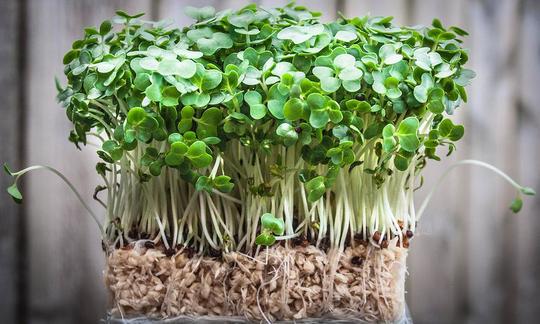

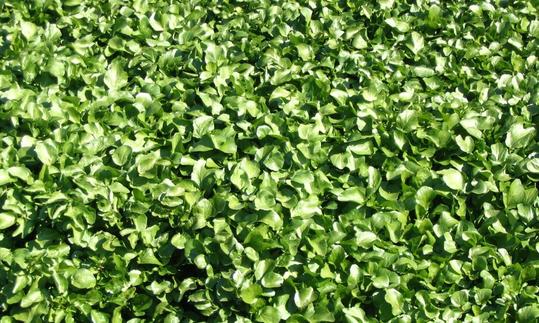

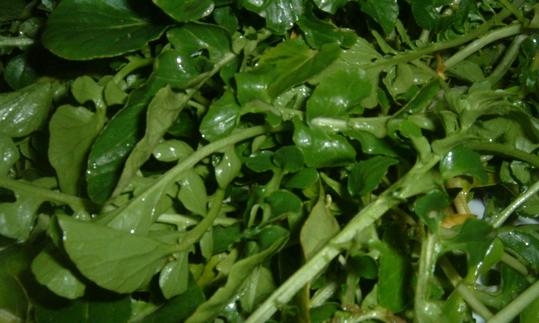

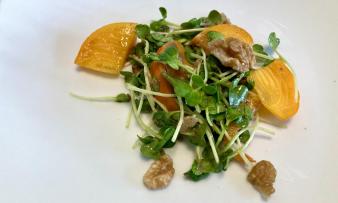
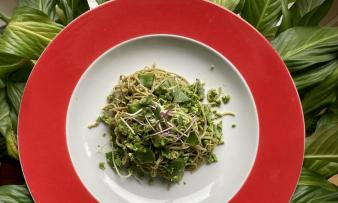
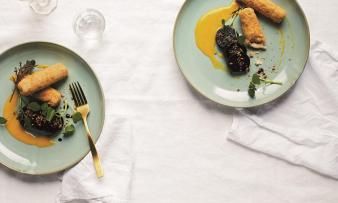

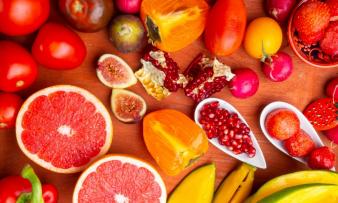



Comments